All good things come to an end. And The Collector went out swinging for the fences! Read about issue 29 only in Ink Stains!
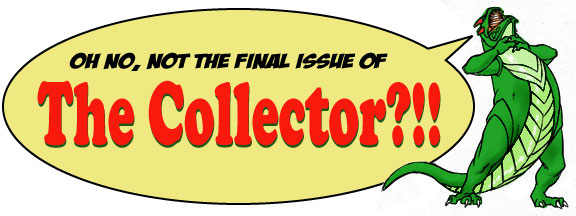 The Collector 29, 1974
The Collector 29, 1974
Editor/Publisher: Bill G. Wilson
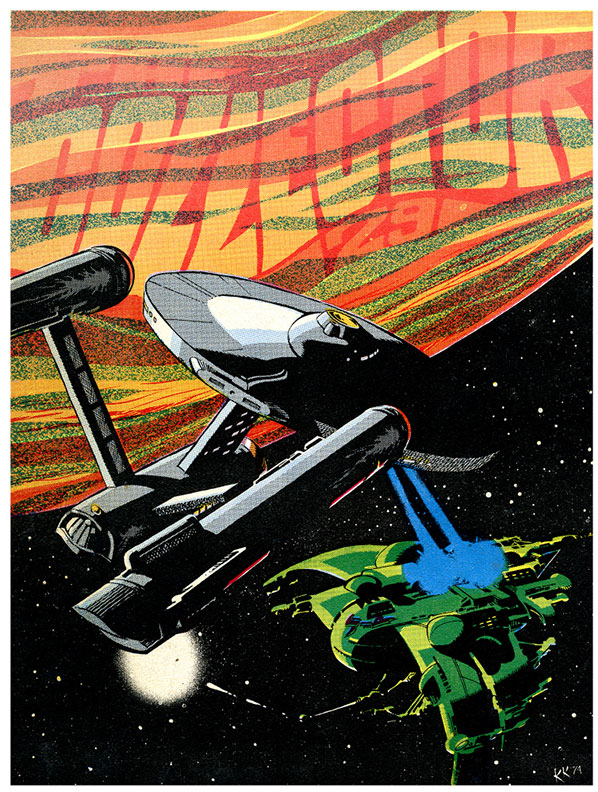
Yes, it is true, The Collector, one of the best and most consistent comic fanzines of its time, ended with this issue, number 29. Editor and publisher Bill G. Wilson went all out too, with the final issue being 100 pages long! Filled with fun and informative articles, and a wide variety of art from his stable of talented artists, along with a few professionals chiming in on this swan song. Let’s get busy! We can start with the cover by longtime contributor Robert Kline of the Enterprise in battle, with a subtle Steranko-like logo in the background. Boasting both exterior and selected interior color in this issue, the usually high production values continue in this last issue.
The editorial is particularly poignant this time out, for several reasons. Most obviously, as the title of the column suggests, this is The Collector‘s Swan Song. But more importantly, it is dedicated to Wilson’s mother, who passed away only months before the 1974 publication of this issue. Wilson talks about how much of a help his mother was in the making of this great fanzine from the very beginning, when Wilson was only 11-years-old! She helped in virtually every aspect of the assemblage and publication of The Collector, and her passing of course affected Wilson deeply. Bill talks below about the very early days of The Collector and his mom’s valuable help.
Because of that great sense of community and the friendships I’d built through Batmania, requests for contributions were granted with ease, much to my shock and amazement, to be honest. But production was the biggest challenge. I knew nothing about printing – especially photo-offset printing, which I’d chosen over mimeo or its “slick” “professional” look – and what I did learn early on was culled from correspondence with other publishers. In fact, early issues of TC were sent off to an Insty-Print which the Menomonee Falls Gazette boys used. I was just a kid, and it never dawned on me that there might be printers in my own area more than capable of handling a little B&W fanzine.My mom had been a secretary and an office manager, so I get my organizational skills from her. My dad gets the blame for my sense of humor and my creative side. But without question Mom’s help with the bookkeeping and correspondence was indispensable; she even came up with a way to keep track of readers and contributors and other correspondents that would put most databases to shame. And this was long before computers!As for the printing, I mentioned that I sent off those early issues to a printer hundreds of miles away because I knew nothing about any printers in my area. But that all changed when I discovered Prince Printing in my own home town. The owner, Joe Prince, was impressed with my work and offered to show me the ropes of the printing biz, if I was interested. Of course I was, and when he upped the ante by agreeing to print TC for free in exchange for my time spent working after school and on Saturdays learning the craft (and doing everything from stocking shelves to making deliveries to cleaning up as a “printer’s devil”), I was hooked. I spent a decade in that shop, eventually honing my skills in the darkroom, as a typesetter (both cold and hot type), on press (offset and letterpress) and in management. That experience taught me design, production and business lessons that have served me well my entire life.
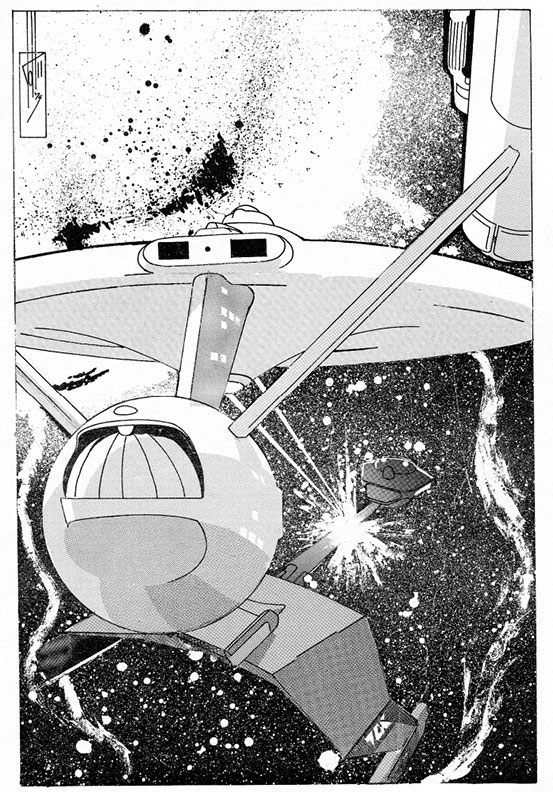
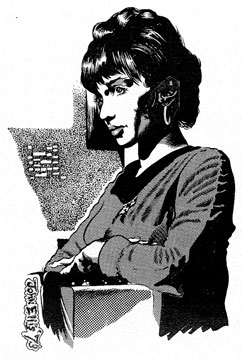 As with many issues, there are a few overriding themes, supported by articles and illustrations. There are several sections, each devoted to Star Trek, The Shadow, Doc Savage, and Captain Marvel (the C. C. Beck Marvel, that is). In addition to the Kline cover, the Star Trek section is started off with an illustration of the star ship by John Byrne, seen above. Byrne had done several space ship illustrations around this time for fanzines such as RBCC, and it leads perfectly into an interview with the one and only Walter Koenig…that’s right, Chekov was in a fanzine! Wilson’s postal interview with the actor reveals him to be a humble and intelligent subject, as well as a big little book fan! He is also very appreciative of The Collector’s quality and a generally nice guy. Following the interview is a Star Trek article by Scott B. Miller and Joseph P. Fellabaum, augmented by the truly gorgeous stippled artwork of Stephen Fabian. There are also illustrations by Skip Olson, Ed Lancaster, Bruce Patterson, and Joe Sinnott. John Ellis also shows his fondness for zipatone with the nice illo of Uhura, seen at left. Fabian contributes many illustrations throughout this issue, all elegantly done (see below). By this time Fabian had just started working as a professional for science fiction digests such as Galaxy, Amazing, and Fantastic, so it is a treat to see his work here in such abundance. Check out his site here and see much more!
As with many issues, there are a few overriding themes, supported by articles and illustrations. There are several sections, each devoted to Star Trek, The Shadow, Doc Savage, and Captain Marvel (the C. C. Beck Marvel, that is). In addition to the Kline cover, the Star Trek section is started off with an illustration of the star ship by John Byrne, seen above. Byrne had done several space ship illustrations around this time for fanzines such as RBCC, and it leads perfectly into an interview with the one and only Walter Koenig…that’s right, Chekov was in a fanzine! Wilson’s postal interview with the actor reveals him to be a humble and intelligent subject, as well as a big little book fan! He is also very appreciative of The Collector’s quality and a generally nice guy. Following the interview is a Star Trek article by Scott B. Miller and Joseph P. Fellabaum, augmented by the truly gorgeous stippled artwork of Stephen Fabian. There are also illustrations by Skip Olson, Ed Lancaster, Bruce Patterson, and Joe Sinnott. John Ellis also shows his fondness for zipatone with the nice illo of Uhura, seen at left. Fabian contributes many illustrations throughout this issue, all elegantly done (see below). By this time Fabian had just started working as a professional for science fiction digests such as Galaxy, Amazing, and Fantastic, so it is a treat to see his work here in such abundance. Check out his site here and see much more!

Robert Kline, by this time a professional animator (which explains his virtual absence from fandom by this point), is featured in an article on his Star Trek cartoon animation work. Kline explains in the article how the actual production process is broken down, and shows many illustrations of ships and creatures to illuminate the text. The work is, of course, much simpler looking than the work we fanzine readers were used to seeing from him, but he does contribute a back cover that shows us how much fun he has with a brush. Below you see that back cover, as well as one of the illustrations from the animation article. Of his fanzine work in general up until his animation career started, Robert said via email that he was attending “the Art Center in Hollywood a full 6 days a week, which made it very tough to do fan work too. From time to time I was able to combine a class assignment with something a fanzine would want to print, and I did that whenever I could.”
Bill Wilson garnered many great friendships over the years while putting together this great fanzine. Below he talks about many of them.
I regret I’ve lost contact with many over the years, but thankfully John Fantucchio and Joe Sinnott have stayed in touch. Both are still going strong, John with his gallery shows and Joe inking the Spider-Man Sunday strip. But the distance means it’s been years since I’ve seen John and I only got back to seeing Joe for the first time in years here recently. There were only a few years between the end of TC and my beginning Questar [his sf/fantasy magazine, published from ’78-81, which ended up with a circulation more than 50 times the fanzine, look here], so my “sabbatical” wasn’t too damaging to my contacts. But after Questar died I went underground and only recently started reestablishing contacts…most notably after an enjoyable reunion with old friends at Comic-Con in honor of fandom’s 50th Anniversary back in 2011.Fantucchio: I mentioned spelling hisname wrong, which made it a bit uncomfortable the first time Mom and Dad and I visited John and Mary at their home in Arlington. I still have a pic of me leaning over John’s drawing board, complete with my nehru shirt and medallion hanging around my neck. God, it’s a wonder they ever let me back in that house! (But, thankfully, over the years I would be a guest at the Fantucchio’s on many occasions, and they even made the trek up to Pittsburgh to visit us once.)
Bob Kline: I remember visiting him when Dad and I took a trip out to California just after TC ended. It must’ve been about ’75 or so, as he was working at Filmation on the Star Trek Saturday morning show; those production sketches of his I ran in that Star Trek article in TC29 are prized items in my collection.Joe Sinnott: I remember Joe coming up to me at my booth at one of Phil’s NY cons and presenting me with a great pic of me as a newspaper kid hocking TC like the Grit newspaper and the Thing behind me yelling “It’s great, gang!” And as thrilled and happy and surprised as I was by such a tremendous gift, I remember poor Joe feeling so bad and embarrassed because, unbeknownst to him, I’d had quite the growth spurt in that year between cons and I no longer looked like the short little chubby Bill G. Wilson he had portrayed! But I loved it, and I ran it in TC. You can’t put a price on such a gift, or on such a friendship, and I’m proud (and frankly embarrassed) to say I’ve been blessed with many of them over the years.
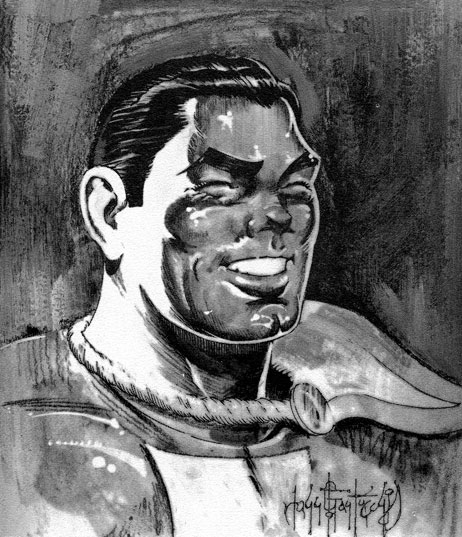 The next section of this issue dives into ol’ señor Shazam himself, Captain Marvel. Several articles cover the Big Red Cheese, including fanzine regular Bill Cantey (Captain Marvel and Company), William Reynolds (Shazam! is the Name of the Game and Captain Marvel’s Rogues Gallery), and RBCC publisher Jim Van Hise (The Adventures of Captain Marvel). Also included is a short article/interview with DC Marvel artist Kurt Schaffenberger. The articles cover the Fawcett years, DC’s incarnation, as well as the Republic serials. There is also a related article by original Marvel artist C. C. Beck. Illustrations for this section of the mammoth final issue are by Collector regulars John G. Fantucchio, Bill Black, Jim Jones, and John Ellis, as well as work by Comic Crusader‘s Martin Griem, Bruce Patterson, Stephen Fabian, Joe Sinnott, Jim Hanley, R. C. Harvey, and John Adkins Richardson. Also included are some very nice full page illustrations by Ken Barr and Clyde Caldwell, a selection of the art seen below the Schaffenberger full page below. Caldwell contributed to many fanzines, and went on to a very successful fantasy art career. You can see his site here.
The next section of this issue dives into ol’ señor Shazam himself, Captain Marvel. Several articles cover the Big Red Cheese, including fanzine regular Bill Cantey (Captain Marvel and Company), William Reynolds (Shazam! is the Name of the Game and Captain Marvel’s Rogues Gallery), and RBCC publisher Jim Van Hise (The Adventures of Captain Marvel). Also included is a short article/interview with DC Marvel artist Kurt Schaffenberger. The articles cover the Fawcett years, DC’s incarnation, as well as the Republic serials. There is also a related article by original Marvel artist C. C. Beck. Illustrations for this section of the mammoth final issue are by Collector regulars John G. Fantucchio, Bill Black, Jim Jones, and John Ellis, as well as work by Comic Crusader‘s Martin Griem, Bruce Patterson, Stephen Fabian, Joe Sinnott, Jim Hanley, R. C. Harvey, and John Adkins Richardson. Also included are some very nice full page illustrations by Ken Barr and Clyde Caldwell, a selection of the art seen below the Schaffenberger full page below. Caldwell contributed to many fanzines, and went on to a very successful fantasy art career. You can see his site here.

Immediately following the Captain Marvel section is a funny two page strip by R. C. Harvey called Zero Hero, featuring two of Harvey’s characters, as well as Marvel himself. After that whimsical piece, Steve Ditko immerses us in the anti-communist strip Libage vs. Chain, Chain being a communist chain wielding super heroine of sorts, and Libage being an “agent of liberty.” We are then greeted by two full page creature illustrations by Skip Olson, and “A Short History of Pulp Fandom” by an authority on the subject, Robert Weinberg. Within this section, there is also an article by Murray Bishoff that compares and contrasts the heroes of the pulps vs. the comics, featuring The Shadow, The Spider, Doc Savage, and more. Many nice illustrations abound by artists such as Jim Pinkoski, R. C. Harvey, Howard Bender, Stephen Fabian, Clyde Caldwell, and Joe Sinnott, as well as some cover reproductions and interior art from the pulps. Below is one of Doc Savage.
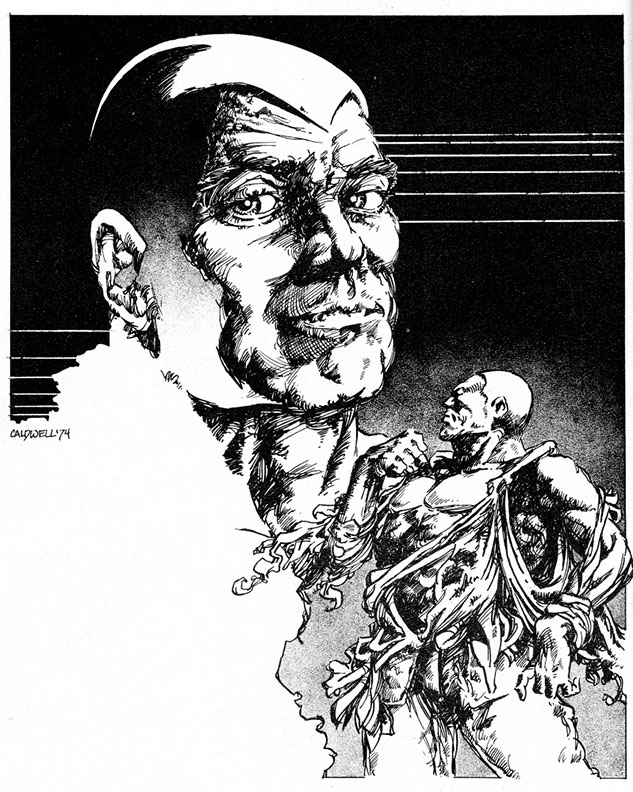
 Following the two big themes are a variety of articles and features. Included are Resurrection of a Spirit (with a very nice Don Newton spot illustration), which deals with the post-newspaper strips, including the great Warren run. In addition to the Newton piece, we have a full page running Spirit by Eisner himself, as well as cover and interior reproductions, and a full page illustration by Bill Black (credited as “Will Black”). A Perry Rhodan article by Steven Wright follows, illustrated by reproductions of covers from the plethora of incarnations of the character, as well as illustrations by Mike Roberts, John Ellis, and Ed Lancaster. A short mini-portfolio of Fantucchio’s work follows, as well as the last chapter of Jim Hanley’s lovingly detailed Greenhorn. In addition to multiple Hitlers, a wide array of golden age knockoffs appear, as seen below.
Following the two big themes are a variety of articles and features. Included are Resurrection of a Spirit (with a very nice Don Newton spot illustration), which deals with the post-newspaper strips, including the great Warren run. In addition to the Newton piece, we have a full page running Spirit by Eisner himself, as well as cover and interior reproductions, and a full page illustration by Bill Black (credited as “Will Black”). A Perry Rhodan article by Steven Wright follows, illustrated by reproductions of covers from the plethora of incarnations of the character, as well as illustrations by Mike Roberts, John Ellis, and Ed Lancaster. A short mini-portfolio of Fantucchio’s work follows, as well as the last chapter of Jim Hanley’s lovingly detailed Greenhorn. In addition to multiple Hitlers, a wide array of golden age knockoffs appear, as seen below.
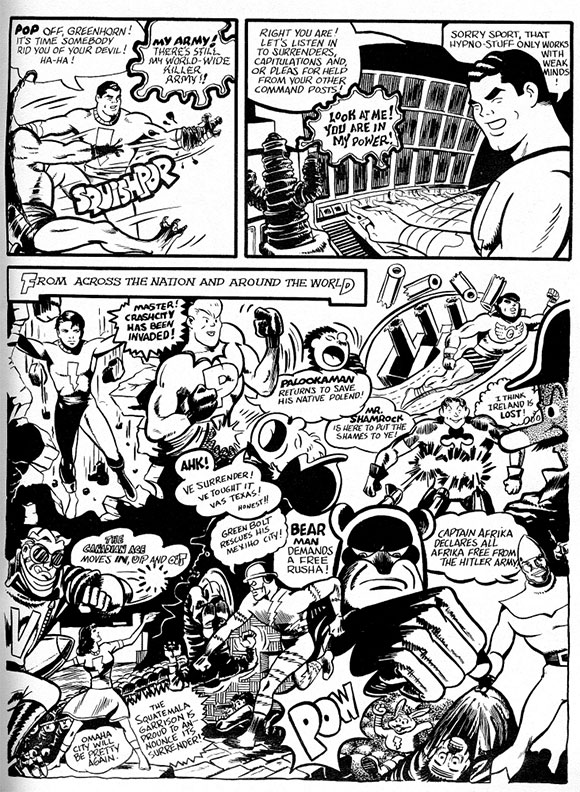
Rounding out the last issue are a full page John Byrne New Gods illo, a letters page, more nicely done spot illustrations, a mini feature on artist Clifford Neal, two Bill Black pin ups, and the wonderfully clean Joe Sinnott illustration seen below, probably the best way to end this article.
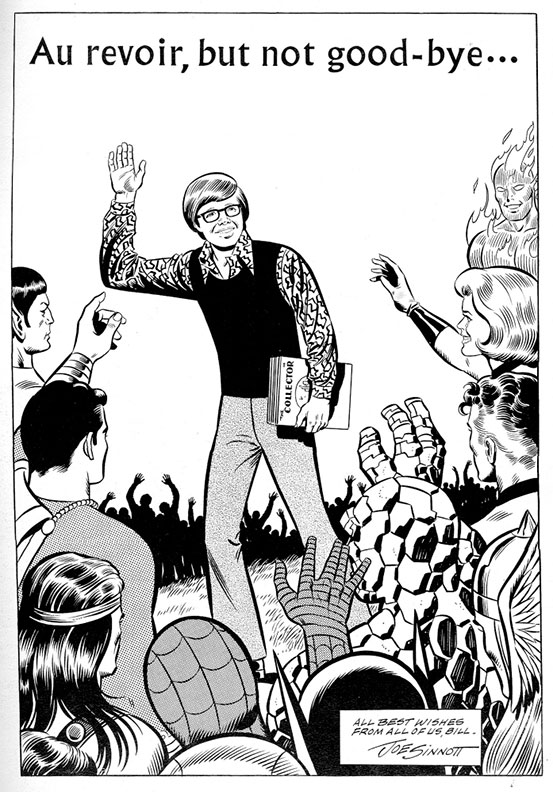
Bill Wilson’s The Collector was one of the best fanzines of its time, and I was sad to see it go. Luckily for you, my fellow fanzine enthusiast, Aaron Caplan, agreed to let me borrow several earlier issues of this great zine that I have never seen. I will be able to feature them at a later date (and more from the Wilson interview), thanks to his goodwill. Of course, life continued for Bill Wilson after The Collector (at the time of this last issue, he was only 19, after all), as he expounds upon below.
I took time off and concentrated on the printing business and my studies, thinking I’d go back to school full-time after some time working but never did. I eventually became manager of Prince Printing and almost considered buying the place when Mr. Prince retired. But I moved on to a bigger company in downtown Pittsburgh, eventually managing one of their satellite shops before joining an agency as a graphic designer shortly after I began Questar. For a brief time Questar was my full-time job, as its light shone brightly for four years as it grew from a basement operation in my home to the basis for a full-fledged publishing company with nice, “eclectic” offices in downtown Pittsburgh that featured original art and movie posters on the walls and one of the “Coma” bodies as “receptionist.” I consider Questar the highlight of my career, as it afforded me the opportunity to rekindle old relationships from the fandom days and establish new ones, building on what I’d started with TC and moving to the professional realm.I moved to Florida after Questar folded and my father, who had retired here years before, became ill. I became a mild-mannered advertising artist for a great metropolitan newspaper, the St. Petersburg Times, and I even met my wife Beth there, the Lois to my Clark. (Or, to be more accurate, my Lana; she’s a redhead.) When I left the Times in ’90 I went into business for myself and I’ve been independent ever since, doing print, publication and web work for a variety of clients with Wilson-Lewis-Wilson Design.
As for this outing, thanks go out to Robert Kline and Bill Wilson for answering questions via email. This issue was so big, I had to supply you with the downloads in three parts, so go here to see all the rest…and there is a lot more to see!
Ken Meyer Jr.
ken@comicattack.net


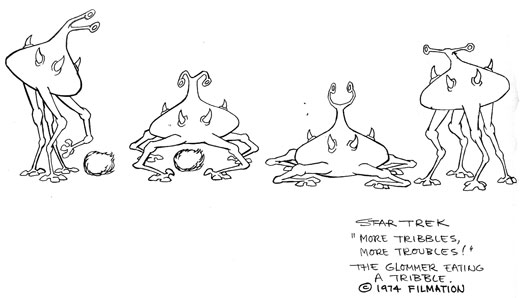
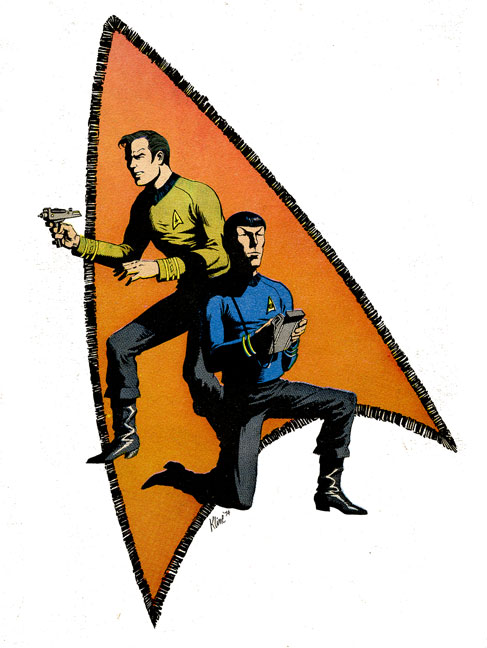
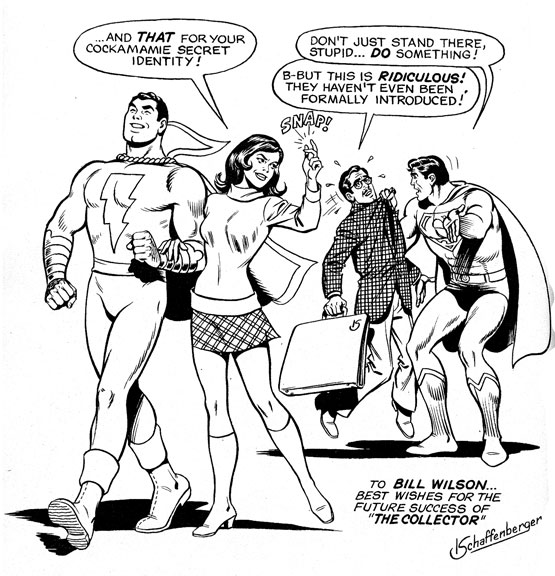
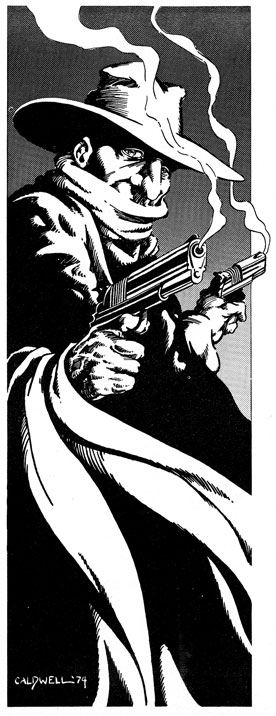

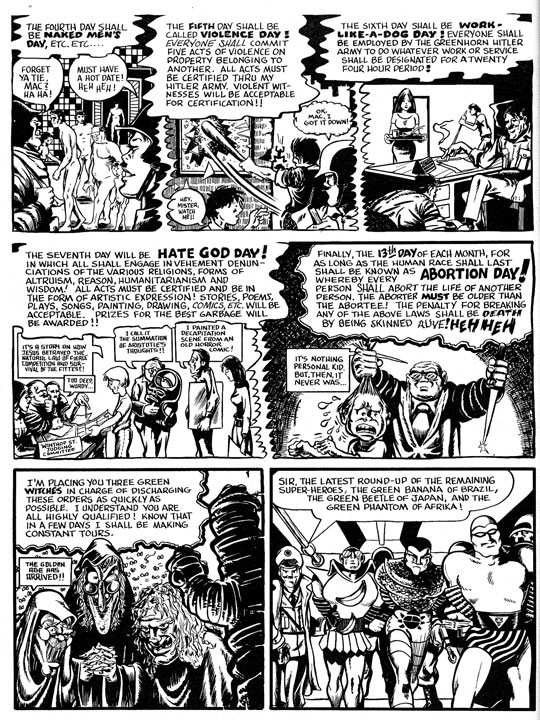
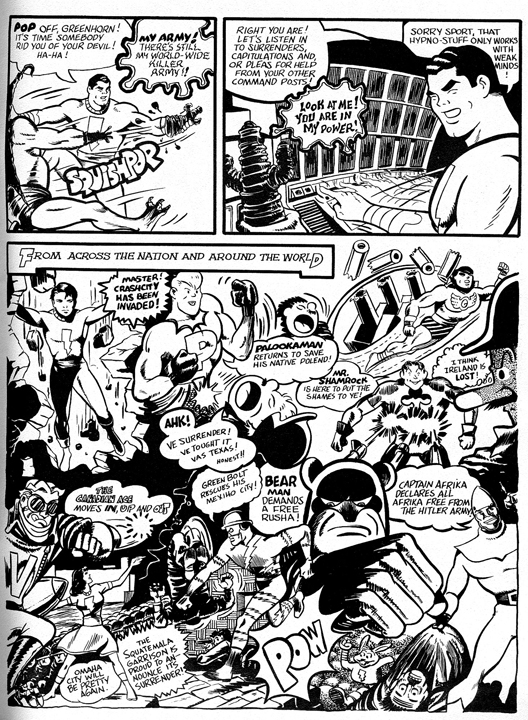

Geez, they sure don’t make ’em like THIS anymore!
Regarding Walter Koenig, he was a huge fan of pop culture himself and was an avid collector of Big Little Books. He was featured on the cover of “The Buyer’s Guide for Comic Fandom” #201 (Sept. 23, 1977) with his collection on the bookshelves in the background, and had a five-page interview published in that issue as well.
Yup, Russ, you are right there! And I was very lucky to connect with Bill in time for this column!
Great job Ken. It’s just as I remembered, and thanks for the kind words.
Thanks for taking the time to stop by, Bob!
So nice to be remembered so fondly. Thanks, Ken.
You are very welcome, Bill…it’s the least I could do, considering how many great memories I have of the Collector and your other zines! Thanks for stopping by!
Great job! Nice to see the SPIRIT piece again. I’d forgotten that I’d done it. I should connect with BGW again since we are both in FL.
My wife just found a box of old fanzines out for the trash including many issues of rocketblast comiccollector and this issue of the collector. I am in shock that anyone would throw these out and so glad she found them.